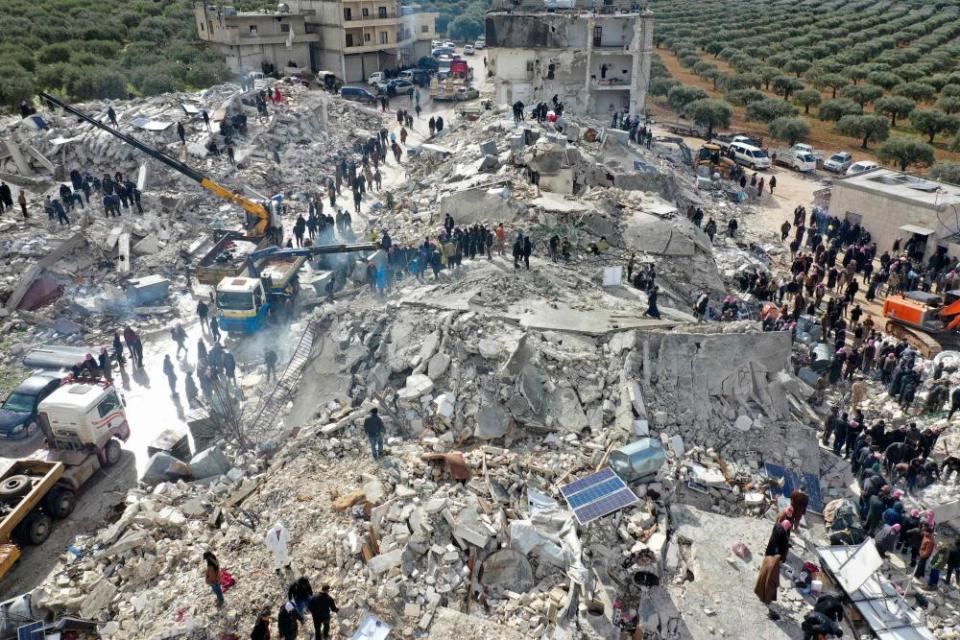Syria earthquake aftermath: why is situation so bad in war-ravaged country?

Syria bears the scars of 12 years of brutal war, the effects of which are likely to hamper aid efforts in the areas worst hit by the quake. Beset by conflict, food shortages, economic collapse and a recent cholera outbreak, the country’s national infrastructure has been at crisis point for years, barely able to support its war-weary population.
And that was before the worst earthquake to hit the region in decades struck.
Related: ‘There is nothing left’: earthquake adds to suffering in war-torn Syria
Why has the earthquake caused so much damage?
On average, there are fewer than 20 quakes over 7.0 magnitude in any year, making Monday’s 7.8 event severe.
The region most affected in Syria – the northern area that borders Turkey – had already been decimated by years of war and aerial bombardment that destroyed homes, hospitals and clinics.
Buildings in Aleppo – Syria’s prewar commercial hub – often collapse due to the dilapidated infrastructure, which has suffered from a lack of oversight during the war. In January, 13 people were killed when a five-storey residential building fell down in the city.
Aleppo bore the brunt of the combined Russian-Syrian offensive against rebel-held areas, facing relentless aerial bombardment until the rebel groups were driven out six years ago and the government reclaimed it.
Since then, many Syrians have been living in damaged buildings as there has been no systematic reconstruction of residential areas. State services remain minimal.
Can aid get to the areas that need it?
The UN says damage to roads, fuel shortages and harsh winter weather will make it difficult.
The province of Idlib, in the country’s north-west, was among the areas worst hit by the earthquake. Idlib is the country’s last rebel-held enclave. After more than a decade of fighting, millions of refugees have settled in this region, which remains outside government control.

“The infrastructure is damaged, the roads that we used to use for humanitarian work are damaged, we have to be creative in how to get to the people … but we are working hard,” the UN resident coordinator, El-Mostafa Benlamlih, told the Reuters news agency.
The government in Damascus also only allows aid to enter the region through one border crossing. The Syrian Association for Citizens’ Dignity has said all crossings must be opened on an emergency basis.
Syria has been resistant to allowing aid into a region serving more than 4 million people because it regards the aid as undermining Syrian sovereignty and reducing its chances of winning back control of the region.
“The areas worst affected by the earthquake inside Syria look to be run by the Turkish-controlled opposition and not by the Syrian government,” said Mark Lowcock, the former head of UN humanitarian affairs. “It is going to require Turkish acquiescence to get aid into those areas. It is unlikely the Syrian government will do much to help.”
What was the situation in the north before the earthquake hit?
The frontlines of Syria’s war have been largely frozen for years, but a deepening economic crisis has led to fuel shortages, increased power cuts and growing deprivation.
The UN estimates that more than 4 million people in north-west Syria – many displaced by the conflict and living in camps – depend on cross-border aid for their day-to-day survival.
In the past, the opposition has accused Syria’s president, Bashar al-Assad, of withholding services from districts where the rebellion against him flared, in order to punish residents.
Additionally, dozens have been killed in a cholera outbreak that has been attributed in part to the country’s crumbling infrastructure.
Will aid to Syria need to be increased?
Even before the earthquake hit, the United Nations said the number of people in need of humanitarian support was greater than at any point since the war began, with 70% of the population requiring aid.
Last week, the World Food Programme warned that hunger rates in Syria were at their highest point since the war began; 2.9 million were at risk of sliding into hunger, while a further 12 million did not know where their next meal was coming from, the UN agency said.
The UN estimates 90% of the 18 million people in Syria are living in poverty, with the economy blighted by conflict, drought and the Covid pandemic as well as the fallout from the financial crash in neighbouring Lebanon.
Benlamlih says the earthquake will only make the situation worse. “They are the same people – suffering more,” he says.
But despite the rolling crises through which most Syrians are forced to live, international support remains underfunded. The UN received less than half of the $4.4bn (£3.7bn) it required from donors to meet growing needs in 2022, and if that trend continues, Benlamlih said the prospects for a recovery from the Syrian crisis could dim.
Additional reporting by Patrick Wintour, Reuters and Agence-France-Presse

 Yahoo Movies
Yahoo Movies 
